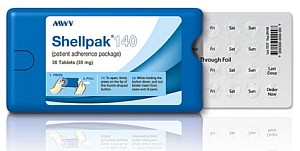A study of drug packaging indicates that calendar blister packaging with days or dates printed on the card under the individual dose helps patients keep to the prescribed schedule for those drugs. The results of the study appeared in the May 2011 issue of the journal Clinical Therapeutics (paid subscription required).
Poor medication adherence leads to increasingly poor health outcomes for patients and has a significant negative economic impact on health care resources. The Center for Connected Health cites a recent WHO report that half of patients with chronic disease do not take their medication as prescribed.
The study tested the impact of medications in calendar blister packaging (CBP) — in this case, Shellpak packaging made by Mead Westvaco — against the same drugs from traditional vials. The researchers from the consulting firm Venebio Group in Richmond, Virginia and Virginia Commonwealth University also in Richmond, analyzed dispensing records from Wal-Mart pharmacy records. The prescriptions were for the generic cardiovascular medications lisinopril or enalapril, either alone or with hydrochlorothiazide.
The sample of records covered 325,361 new and ongoing users of the drugs, age 18 to 75, over two years. After the first year, the drugs for the test cohort were packaged in CBP rather than vials. The researchers used measures of refill adherence and persistence in the baseline year before and follow-up year after the packaging switch, and tabulated the results by new and ongoing users.
The study team found some improvement overall in medication persistence and adherence for participants taking their pills from CBP. The most pronounced differences in persistence were found among new medication users who had an average length of therapy increase of 9 days over a year. Ongoing medication users had an average length of therapy increase of 5 days over a year.
The measures of refill adherence included proportion of days covered and medication possession ratio. CBP users were more likely to reach full refill adherence — defined as at least 80% of days covered with medication in a year — than vial users, at all levels of baseline adherence: low, medium, and high. The researchers found no statistical differences between CBP and vial users in medication possession ratio.
Read more: Standards Proposed for Prescription Drug Labels
* * *


 RSS - Posts
RSS - Posts
[…] Read more: Calendar Blister Packs Shown to Help Medication Adherence […]